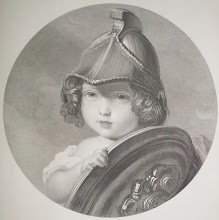Arriving at the Library in 28 containers, curators have been presented with a vast collection which reflects Peake's creative endeavours across an astonishing variety of media and forms.
Included are 39 autograph Gormenghast notebooks – the novel for which Peake won the Heinemann Prize for Literature in 1951 – as well as the complete set of original drawings for Lewis Carroll's Alice Through the Looking Glass and Alice in Wonderland.
Complete illustration of the Jabberwocky from Alice through the Looking Glass (1945). Peake Estate
Lesser-known short stories, war poems, radio plays and nonsense also feature in a display curators are describing as a "uniquely visual" archive, that sheds light on the way Peake moved easily between visual and written mediums.
"Mervyn Peake occupies an almost unique position as a creative artist equally gifted in literature and art," explains Rachel Foss, the British Library's Curator of Modern Literary Manuscripts.
"The acquisition of his complete archive now allows researchers to view Peake's life and work as an integrated, organic whole, and to understand the way his creative endeavours were balanced across an extraordinary interplay of text and image."
For Peake, writing and drawing were interchangeable. Many of his characters were visualised through lively sketches which were then woven into his gothic narratives. The result is a unique interaction of text and images.
Notebooks with Peakes draft for the Gormenghast novels (1940s). Peake Estate
In his introduction to the 1949 Grey Walls Press publication of his drawings, Peake wrote that the problem of the artist is “to discover his language…out of such drawings and hundreds more my own language will develop."
His illustrations for Carroll's stories exemplify his belief that the purpose of illustration is to invest another dimension into the text, not simply to act as an aesthetic accompaniment to it.
Further highlights of the archive include two poetry notebooks – again packed with sketches – typescripts of short stories, juvenilia and a swathe of lively correspondence taking in literary and artistic figures ranging from CS Lewis and Dylan Thomas to Laurence Olivier and Orson Welles.
Peake's frontispiece for Gormenghast. © Peake Estate
Correspondence with his wife, Maeve Gilmore, comprises postcards and letters including nine from Germany when he was commissioned as a war artist by The Leader magazine, observing war-crimes trials in Germany, and entering the Bergen-Belsen concentration camp.
The £410,000 acquisition, which has been party funded by The Art Fund, comes on the back of some high profile acquisitions for the Library including John Berger, Angela Carter, and Ted Hughes. It has been welcomed by the Peake Estate as being in accordance with the late author's wishes.
"The decision vindicates my mother's unswerving belief in her husband's art," said Peake's son, Sebastian.
"My mother always felt strongly that this artistic eclecticism should one day be shared with the nation." Peake Jnr also took the opportunity to thank his father for "a wonderful legacy", his mother for "her dedication to promoting it" and the British Library for "making her wish come true".
Once catalogued, the treasure trove of research material is expected to be made accessible to researchers in early 2011.

No comments:
Post a Comment